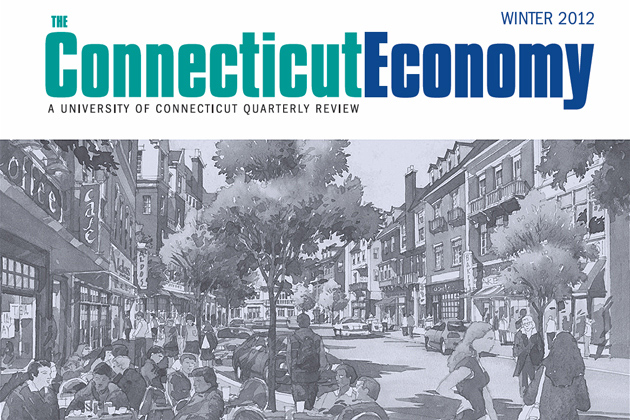
The winter issue of The Connecticut Economy examines how we might live in the future, assessing quality of life and ranking Connecticut 12th in a survey of which states offer the best value for the money.
North Dakota, where winter temperatures average 2 degrees F in parts of the state, ranked first.
Like beauty, quality of life is in the eye of the beholder, says Steve Lanza, executive editor of the quarterly magazine, which is published by the Department of Economics in the College of Liberal Arts and Sciences.
But his weighted scale of life’s quality, in which housing prices and taxes help determine an ideal environment, gives North Dakota the edge for having the highest quality of life at the lowest cost.
The variables in his analysis fell into two broad groups: assets, such as health, education, and income; and liabilities, such as pollution, crime, poverty, and unemployment.
Rainfall, one of the variables considered in the scale, might have worked against Connecticut this year, the state’s wettest ever.
New Hampshire ranked second nationally on an “efficiency index” that measured high quality at low cost. Vermont was fifth, and Massachusetts eighth.
Maine and Rhode Island ranked 13th and 14th, just behind Connecticut.
In weighting the variables other ways, Connecticut ranked as high as second (when assets were considered more important than liabilities), or fifth (when assets and liabilities had equal weight), and as low as 14th (when liabilities were given more weight).
Chief among the state’s liabilities was income inequality.
“There is no shortage of statistics that reflect the quality of life,” Lanza wrote in the new issue. “The trick is to combine these apples-and-oranges indicators of general well-being into a single metric.”
And, he says, “No matter how you slice it, Connecticut offers a premier quality of life. What’s more, 13 percent of the U.S. population, one third of the country’s income, and 18 percent of its advanced-degree holders lie within a 200-mile radius of Hartford.”
To hear Lanza discuss the survey, click here.
Prospects for improving the quality of life are considered in the new issue, including the growing interest in mixed-use development. Often called “smart growth,” mixed use developments combine retail, residential, and commercial uses in close proximity, requiring “an extraordinary degree of cooperation and coordination between developers, builders, financial institutions, community groups, and various layers of government,” says Dennis Heffley, professor of economics.
The Storrs Center development, now being built, might become a model for how small college towns can attract the amenities of a big city, Heffley writes.
But the idea for mixed use is an old one, he notes. Gurleyville, a village of Storrs-Mansfield that thrived in the 19th century, was an early version. It consisted of a button factory, a gristmill, a corner store, and colonial homes. Residents could walk to work on the farm, mill, or factory.
That model disappeared in the late 1800s and early 1900s, followed by a long period of suburbanization.
“Once regarded as a planning anachronism, mixed-use development has enjoyed a rebirth of popularity,” Heffley says.
The first phase of Storrs Center, slated to open in August 2012, may provide a glimpse of this future.
Also in the winter issue is an assessment of poverty rates since the recent recession. Connecticut has fared worse relative to other states, and the data suggest a longer-term increase in the incidence of poverty here, according to an analysis by Arthur Wright, emeritus professor of economics.
In the jobs outlook:
- Connecticut lost 1,400 jobs in the third quarter of 2011, erasing 40 percent of a 3,400 gain in the second quarter.
- The health sector added 1,600 jobs in the third quarter, and manufacturing added 1,100. But the public sector lost 1,500 jobs, and losses were also seen in the financial and professional/business services sectors.
- Any meaningful Connecticut job gains will not occur until the last half of 2012, if US GDP growth remains as slow as expected. The Hartford labor market has the best prospects for growth, and could add 3,500 jobs by the third quarter of 2012.
- Unemployment eased to 8.9 percent from 9.2 percent statewide in the third quarter a year ago.



